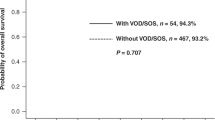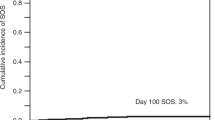Abstract
Hepatic veno-occlusive disease (VOD) is a major complication after hematopoietic stem cell transplantation (HSCT). Aetiological determinants, diagnosis and treatment remain unclear. Changes in coagulation-fibrinolysis parameters and N-terminal propeptide for type III procollagen (P-III-P) have been studied in patients with or without VOD after HSCT. We prospectively measured protein C activity, tissue plasminogen activator (t-PA), antithrombin III (AT-III), plasminogen activity (PLG), thrombin-antithrombin III (TAT), α2-plasmin inhibitor (α2-PI),fibrinogen (Fbg) and P-III-P in 44 consecutive adult patients undergoing allogeneic HSCT. Each parameter was determined before conditioning, on day 0 of HSCT and weekly for 5 weeks. Five of the 44 patients developed VOD at a median post HSCT of day 3 (range, day 3 to 12). On repeated analysis of variance (ANOVA), there were significant differences between patients with and without VOD in P-III-P (P < 0.0001), protein C (P < 0.0001), t-PA (P < 0.0001), PLG (P < 0.0001), AT-III(P < 0.0001), Fbg (P < 0.0001), α2-PI (P = 0.0002). Levels of P-III-P were significantly higher in patients with VOD than without VOD, before preparative chemotherapy (P < 0.005) and on days 0 and 7 (P < 0.001). On day 0, levels of t-PA were significantly higher in patients with VOD than without VOD (P < 0.05). On day 7, levels of protein C were significantly lower in patients with VOD than without VOD (P < 0.01). On day 0, there were trends of differences (P = 0.0515) between patients with and without VOD in the levels of protein C. These results suggest P-III-P, t-PA and protein C are predictive markers for VOD after HSCT in adults. Moreover, the serum P-III-P level before start of conditioning might indicate patients at risk for developing VOD. Bone Marrow Transplantation (2000) 26, 881–886.
This is a preview of subscription content, access via your institution
Access options
Subscribe to this journal
Receive 12 print issues and online access
$259.00 per year
only $21.58 per issue
Buy this article
- Purchase on Springer Link
- Instant access to full article PDF
Prices may be subject to local taxes which are calculated during checkout


Similar content being viewed by others
References
McDonald GB, Sharma P, Matthews DE et al. Venocclusive disease of the liver after bone marrow transplantation: diagnosis, incidence, and predisposing factors Hepatology 1984 4: 116–122
Locasciulli A, Bacigalupo A, Alberti A et al. Predictability before transplant of hepatic complications following allogeneic bone marrow transplantation Transplantation 1989 48: 68–72
McDonald GB, Hinds MS, Fisher LD et al. Veno-occlusive disease of the liver and multiorgan failure after bone marrow transplantation: a cohort study of 355 patients Ann Intern Med 1993 118: 255–267
Jones RJ, Lee KSK, Beschorner WF et al. Veno-occlusive disease of the liver following bone marrow transplantation Transplantation 1987 44: 778–783
Schulman HM, Hinterberger W . Hepatic veno-occlusive disease-liver toxicity syndrome after bone marrow transplantation Bone Marrow Transplant 1992 10: 197–214
Faioni EM, Krachmalnicoff A, Bearman SI et al. Naturally occurring anticoagulants and bone marrow transplantation: plasma protein C predicts development of venocclusive disease of the liver Blood 1993 81: 3458–3462
Gordon B, Haire W, Kessinger A et al. High frequency of antithrombin 3 and protein C deficiency following autologous bone marrow transplantation for lymphoma Bone Marrow Transplant 1991 8: 497–502
Rio B, Bauduer F, Arrago JP et al. N-terminal peptide of type III procollagen: a marker for the development of hepatic veno-occlusive disease after BMT and a basis for determining the timing of prophylactic heparin Bone Marrow Transplant 1993 11: 471–472
Heikinheimo M, Halila R, Fasth A . Serum procollagen type III is an early and sensitive marker for veno-occlusive disease of the liver in children undergoing bone marrow transplantation Blood 1994 83: 3036–3040
Park YD, Yasui M, Yoshimoto T et al. Changes in hemostatic parameters in hepatic veno-occlusive disease following bone marrow transplantation Bone Marrow Transplant 1997 19: 915–920
Salat C, Holler E, Wolf C et al. Laboratory markers of veno-occlusive disease in the course of bone marrow and subsequent liver transplantation Bone Marrow Transplant 1997 19: 487–490
Tabbara IA, Ghazal CD, Ghazal HH . Early drop in protein C and antithrombin III is a predictor for the development of venoocclusive disease in patients undergoing hematopoietic stem cell transplantation J Hematother 1996 5: 79–84
Scrobohaci ML, Drouet L, Monem-Mansi A et al. Liver veno-occlusive disease after bone marrow transplantation changes in coagulation parameters and endothelial markers Thromb Res 1991 63: 509–519
Salat C, Holler E, Kolb H-J et al. Plasminogen activator inhibitor-1 confirms the diagnosis of hepatic veno-occlusive disease in patients with hyperbilirubinemia after bone marrow transplantation Blood 1997 89: 2184–2188
Lee JH, Lee KH, Kim S et al. Relevance of protein C and S, antithrombin III, von Willebrand factor, and factor VIII for the development of hepatic veno-occlusive disease in patients undergoing allogeneic bone marrow transplantation: a prospective study Bone Marrow Transplant 1998 22: 883–888
Eltumi M, Trivedi P, Hobbs JR et al. Monitoring of veno-occlusive disease after bone marrow transplantation by serum aminopropeptide of type III procollagen Lancet 1993 342: 518–521
Schuler U, Subat S, Schmidt H et al. Evaluation of procollagen-III peptide as a marker for veno-occlusive disease after bone marrow transplantation Ann Hematol 1996 73: 25–28
Kirk JME, Bateman ED, Haslam PL et al. Serum type III procollagen peptide concentration in cryptogenic fibrosing alveolitis and its clinical relevance Thorax 1984 39: 726–732
Rohde H, Vargas L, Hahn E et al. Radioimmunoassay for type III procollagen peptide and its application to human liver disease Eur J Clin Invest 1979 9: 451–459
Kami M, Mori S, Tanikawa S et al. Risk factors for hepatic veno-occlusive disease after bone marrow transplantation: retrospective analysis of 137 cases at a single institution Bone Marrow Transplant 1997 20: 397–402
Hasegawa S, Horibe K, Kawabe T et al. Veno-occlusive disease of the liver after allogeneic bone marrow transplantation in children with hematologic malignancies: incidence, onset time and risk factors Bone Marrow Transplant 1998 22: 1191–1197
Catani L, Gugliotta L, Mattioli Belmonte M et al. Hypercoagulability in patients undergoing autologous or allogeneic BMT for hematological malignancies Bone Marrow Transplant 1993 12: 253–259
Seeber C, Hiller E, Holler E et al. Increased levels of tissue plasminogen activator (t-PA) and tissue plasminogen activator inhibitor (PAI) correlate with tissue necrosis factor alpha (TNF α) release in patients suffering from microangiopathy following allogeneic bone marrow transplantation (BMT) Thromb Res 1992 66: 373–383
Vanhinsbergh VWM, Bauer K, Kooistra K et al. Progress of fibrinolysis during tumor necrosis factor infusions in humans. Concomitant increase in tissue-type plasminogen activator, plasminogen activator inhibitor type-1 and fibrin(ogen) degeneration products Blood 1990 76: 2284–2289
Author information
Authors and Affiliations
Rights and permissions
About this article
Cite this article
Tanikawa, S., Mori, S., Ohhashi, K. et al. Predictive markers for hepatic veno-occlusive disease after hematopoietic stem cell transplantation in adults: a prospective single center study. Bone Marrow Transplant 26, 881–886 (2000). https://doi.org/10.1038/sj.bmt.1702624
Received:
Accepted:
Published:
Issue Date:
DOI: https://doi.org/10.1038/sj.bmt.1702624
Keywords
This article is cited by
-
Autotaxin is a potential predictive marker for the development of veno-occlusive disease/sinusoidal obstruction syndrome after allogeneic hematopoietic cell transplantation
Annals of Hematology (2024)
-
Effect of Sirolimus levels between days 11 and 20 after allogeneic stem cell transplantation on the risk of hepatic sinusoidal obstruction syndrome
Bone Marrow Transplantation (2021)
-
Diagnosis and severity criteria for sinusoidal obstruction syndrome/veno-occlusive disease in pediatric patients: a new classification from the European society for blood and marrow transplantation
Bone Marrow Transplantation (2018)
-
Revised diagnosis and severity criteria for sinusoidal obstruction syndrome/veno-occlusive disease in adult patients: a new classification from the European Society for Blood and Marrow Transplantation
Bone Marrow Transplantation (2016)
-
Early thrombin generation and impaired fibrinolysis after SCT associate with acute GVHD
Bone Marrow Transplantation (2010)



